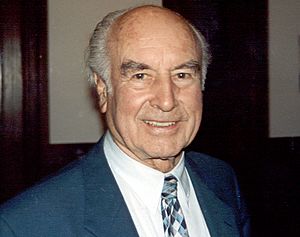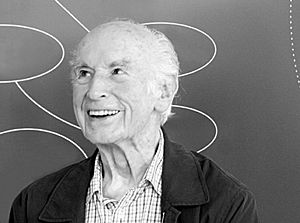Albert Hofmann facts for kids
Quick facts for kids
Albert Hofmann
|
|
|---|---|

Hofmann in 1993
|
|
| Born | 11 January 1906 |
| Died | 29 April 2008 (aged 102) Burg im Leimental, Basel-Landschaft, Switzerland
|
| Alma mater | University of Zürich (PhD) |
| Occupation |
|
| Employer | Sandoz |
| Spouse(s) | Anita Hofmann (died 2007) |
| Children | 4 |
| Relatives | Gustav Guanella (brother-in-law) |
| Awards | Scheele Award |
Albert Hofmann (born January 11, 1906 – died April 29, 2008) was a famous Swiss chemist. He wrote over 100 science articles and many books. In 2007, he was named one of the 100 greatest living geniuses by The Daily Telegraph newspaper, sharing first place with Tim Berners-Lee.
Contents
Early Life and Education
Albert Hofmann was born in Baden, Switzerland, on January 11, 1906. He was the oldest of four children. His father was a factory toolmaker. When his father became sick, Albert worked as a business apprentice while he studied.
At age 20, Albert started studying chemistry at the University of Zürich. He finished his degree three years later in 1929. His godfather helped pay for his education because his family did not have much money. Albert was very interested in the chemistry of plants and animals. He did important research on a substance called chitin, which is found in animals. For this work, he earned his doctorate degree with high honors in 1929.
Career as a Chemist
Albert Hofmann chose to become a chemist because he was curious about the world around him. He once said that childhood experiences made him wonder about how nature works. Chemistry was the science that could help him understand this.
Research at Sandoz
Hofmann became a director at Sandoz, a company that made medicines. He continued to study natural substances. He researched things found in Mexican mushrooms and other plants used by local people.
In 1963, Hofmann went to a big meeting in Stockholm. It was for the World Academy of Arts and Sciences.
Later Years
Albert Hofmann was good friends with a German writer named Ernst Jünger. They met in 1949 and wrote letters to each other for a long time.
Death
Albert Hofmann passed away on April 29, 2008, in Switzerland. He was 102 years old.
Honors and Awards
In 1969, the Swiss Federal Institute of Technology (ETH Zurich) gave him an honorary science degree. They also honored his brother-in-law, Gustav Guanella, at the same time. In 1971, the Swedish Pharmaceutical Association gave him the Scheele Award. This award celebrates the achievements of famous chemists and pharmacists.
See also
 In Spanish: Albert Hofmann para niños
In Spanish: Albert Hofmann para niños
- James Fadiman
- David E. Nichols
- Alexander Shulgin
- Owsley Stanley


